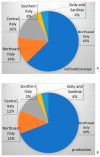Triticale in Italy
- PMID: 37887018
- PMCID: PMC10603945
- DOI: 10.3390/biology12101308
Triticale in Italy
Abstract
Triticale is currently grown throughout the world with a wider diffusion in Europe, with Poland, Belarus, Germany, France and Spain as major producers. Although triticale occupies a very small fraction of the Italian cultivated land (16,000 ha of harvested area, mean value of the past 5 years), a continuous interest for this crop and its possible uses explains the work and progress made by breeding activities in different periods. The aim of this review is to report some experiences related to the cultivation of triticale in Italy. A general long-term view of the performance of triticale varieties in Italy has been distilled from a large amount of data derived from the pluri-decennial Italian national variety trials network. This activity, historically coordinated by CREA-GB, extends over several decades and examines the agronomic performance, in different Italian environments, of the most widespread and emerging varieties of triticale. Indications on new breeding targets can be deduced from the elaborations in the frame of both climatic change and market demands.
Keywords: breeding; certified seeds; triticale varieties; varietal recommended lists.
Conflict of interest statement
The authors declare no conflict of interest.
Figures






References
-
- Arseniuk E. Triticale. Springer International Publishing; Cham, Switzerland: 2015. Triticale abiotic stresses—An overview; pp. 69–81.
-
- Kiss A. Kreuzungsversuche mit triticale [Crossing experiments with Triticale] Züchter Genet. Breed. Res. 1966;36:249–255. doi: 10.1007/BF00452176. - DOI
-
- Mergoum M., Gómez-Macpherson H. FAO Plant Production and Protection Papers. Food and Agriculture Organization of the United Nations; Rome, Italy: 2004. Triticale improvement and production.
-
- Oettler G. The fortune of a botanical curiosity–Triticale: Past, present and future. J. Agric. Sci. 2005;143:329–346. doi: 10.1017/S0021859605005290. - DOI
-
- Del Pozo A., Méndez-Espinoza A.M., Castillo D. Neglected and Underutilized Crops. Academic Press; Cambridge, MA, USA: 2023. Triticale; pp. 325–362.
Publication types
Grants and funding
LinkOut - more resources
Full Text Sources
Miscellaneous

